
Arylcyclohexylamines, also known as arylcyclohexamines or arylcyclohexanamines, are a chemical class of pharmaceutical, designer, and experimental drugs.

Arylcyclohexylamines, also known as arylcyclohexamines or arylcyclohexanamines, are a chemical class of pharmaceutical, designer, and experimental drugs.
Phencyclidine (PCP) is believed to be the first arylcyclohexylamine with recognized anesthetic properties, but several arylcyclohexylamines were described before PCP in the scientific literature, beginning with PCA (1-phenylcyclohexan-1-amine) the synthesis of which was first published in 1907. PCP itself was discovered in 1926 but not researched by pharmaceutical industry until the 1950s. PCE was reported in 1953 and PCMo (4-(1-phenyl-cyclohexyl)-morpholine [1] see chart below for figure) in 1954, with PCMo described as a potent sedative. [2] Arylcyclohexylamine anesthetics were intensively investigated at Parke-Davis, beginning with the 1956 studies of PCP and later the related compound ketamine. [2] The 1970s saw the debut of these compounds, especially PCP and its analogues, as illicitly used recreational drugs due to their dissociative hallucinogenic and euphoriant effects. Since that time, the class has been expanded by scientific research into stimulant, analgesic, and neuroprotective agents, and also by clandestine chemists in search of novel recreational drugs. [3] [4] [5]

An arylcyclohexylamine is composed of a cyclohexylamine unit with an aryl moiety attachment. The aryl group is positioned geminal to the amine. In the simplest cases, the aryl moiety is typically a phenyl ring, sometimes with additional substitution. The amine is usually not primary; secondary amines such as methylamine or ethylamine, or tertiary cycloalkylamines such as piperidine and pyrrolidine, are the most commonly encountered N-substituents.
Arylcyclohexylamines varyingly possess NMDA receptor antagonistic, [6] [7] dopamine reuptake inhibitory, [8] and μ-opioid receptor agonistic [9] properties. Additionally, σ receptor agonistic, [10] nACh receptor antagonistic, [11] and D2 receptor agonistic [12] actions have been reported for some of these agents. Antagonism of the NMDA receptor confers anesthetic, anticonvulsant, neuroprotective, and dissociative effects; blockade of the dopamine transporter mediates stimulant and euphoriant effects as well as psychosis in high amounts; and activation of the μ-opioid receptor causes analgesic and euphoriant effects. Stimulation of the σ and D2 receptors may also contribute to hallucinogenic and psychotomimetic effects. [12]
These are versatile agents with a wide range of possible pharmacological activities depending on the extent and range to which chemical modifications are implemented. [13] [14] [15] [16] [17] [18] [19] [20] [21] The various choice of substitutions that are made allows for "fine-tuning" of the pharmacological profile that results. As examples, BTCP is a selective dopamine reuptake inhibitor, [8] PCP is primarily an NMDA antagonist, [6] and BDPC is a potent μ-opioid agonist, [22] while PRE-084 is a selective sigma receptor agonist. [23] Thus, radically different pharmacology is possible through different structural combinations.
PCP itself is composed of three six-membered rings, which can each be substituted by a variety of groups. These are traditionally numbered in the older research as first the cyclohexyl ring, then the phenyl, and finally the piperidine ring, with the different rings represented by prime notation (') next to the number. For instance, 4-methyl-PCP, 4'-methyl-PCP and 4''-methyl-PCP are all known compounds, with similar activity but quite different potencies.

However, since the widespread sale of these compounds as grey-market designer drugs, nearly all such compounds that have come to prominence either have a bare cyclohexyl ring or a 2-ketocyclohexyl ring, while the piperidine is replaced by a variety of alkyl or cycloalkyl amines and most substitution has taken place on the phenyl ring. Consequently, it is common for widely used phenyl substituted analogues such as 3'-MeO-PCP and 3'-MeO-PCE to be referred to as 3-MeO-PCP and 3-MeO-PCE without the prime, even though this is technically incorrect and could lead to confusion.
| Structures | Compound | Aryl Substituent | N Group | Cyclohexyl ring | CAS number |
|---|---|---|---|---|---|
 | PCA [24] | Phenyl | NH2 | - | 1934-71-0 |
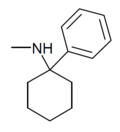 | PCM [24] | Phenyl | Methylamino | - | 2201-16-3 |
 | Eticyclidine | Phenyl | Ethylamino | - | 2201-15-2 |
 | PCPr [25] | Phenyl | n-Propylamino | - | 18949-81-0 |
 | PCiP | Phenyl | Isopropylamino | - | 1195-42-2 |
 | PCAL [26] | Phenyl | Allylamino | - | 2185-95-7 |
 | PCBu | Phenyl | n-Butylamino | - | 73166-29-7 |
 | PCEOH | Phenyl | Hydroxyethylamino | - | 2201-22-1 |
 | PCMEA [27] | Phenyl | Methoxyethylamino | - | 2201-57-2 |
 | PCEEA | Phenyl | Ethoxyethylamino | - | 1072895-05-6 |
 | PCMPA | Phenyl | Methoxypropylamino | - | 2201-58-3 |
 | PCDM [24] | Phenyl | Dimethylamino | - | 2201-17-4 |
 | Dieticyclidine | Phenyl | Diethylamino | - | 2201-19-6 |
 | 2-HO-PCP [6] | Phenyl | Piperidine | 2-Hydroxy | 94852-58-1 |
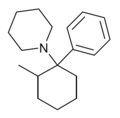 | 2-Me-PCP [28] | Phenyl | Piperidine | 2-Methyl | 59397-29-4 |
 | 2-MeO-PCP [29] | Phenyl | Piperidine | 2-Methoxy | 78636-34-7 |
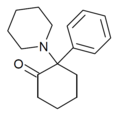 | 2-Keto-PCP | Phenyl | Piperidine | 2-Keto | 101688-16-8 |
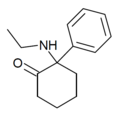 | Eticyclidone ("O-PCE") | Phenyl | Ethylamino | 2-Keto | 6740-82-5 |
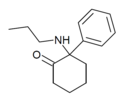 | 2-Keto-PCPr | Phenyl | n-Propylamino | 2-Keto | |
 | 4-Methyl-PCP | Phenyl | Piperidine | 4-Methyl | 19420-52-1 |
 | 4-Keto-PCP [30] | Phenyl | Piperidine | 4-Keto | 65620-13-5 |
 | 2'-Cl-PCP | o-Chlorophenyl | Piperidine | - | 2201-31-2 |
 | 3'-Cl-PCP | m-Chlorophenyl | Piperidine | - | 2201-32-3 |
 | 2'-MeO-PCP | o-Methoxyphenyl | Piperidine | - | 2201-34-5 |
 | 3'-F-PCP [31] | m-Fluorophenyl | Piperidine | - | 89156-99-0 |
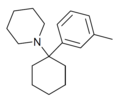 | 3'-Me-PCP [32] | m-Tolyl | Piperidine | - | 2201-30-1 |
 | 3'-Me-PCPy | m-Tolyl | Pyrrolidine | - | 1622348-63-3 |
 | 3'-NH2-PCP | m-Aminophenyl | Piperidine | - | 72242-00-3 |
 | 3'-HO-PCP | m-Hydroxyphenyl | Piperidine | - | 79787-43-2 |
 | 3'-MeO-PCP | m-Methoxyphenyl | Piperidine | - | 72242-03-6 |
 | 3',4'-MD-PCP | 3,4-Methylenedioxyphenyl | Piperidine | - | |
 | 3'-MeO-PCE | m-Methoxyphenyl | Ethylamino | - | 1364933-80-1 |
 | 3'-HO-PCE | m-Hydroxyphenyl | Ethylamino | - | |
 | 3'-MeO-PCPr | m-Methoxyphenyl | n-Propylamino | - | 1364933-81-2 |
 | 3'-HO-PCPr | m-Hydroxyphenyl | n-Propylamino | - | |
 | 3',4'-MD-PCPr | 3,4-Methylenedioxyphenyl | n-Propylamino | - | |
 | 3'-MeO-PCPy [32] | m-Methoxyphenyl | Pyrrolidine | - | 1364933-79-8 |
 | 4'-HO-PCP | p-Hydroxyphenyl | Piperidine | - | 66568-88-5 |
 | Methoxydine (4'-MeO-PCP) | p-Methoxyphenyl | Piperidine | - | 2201-35-6 |
 | 4'-MeO-PCE | p-Methoxyphenyl | Ethylamino | - | |
 | 4'-F-PCP [31] | p-Fluorophenyl | Piperidine | - | 22904-99-0 |
 | 4'-F-PCPy | p-Fluorophenyl | Pyrrolidine | - | |
 | Arketamine | o-Chlorophenyl | Methylamino | 2-Keto | 33643-49-1 |
 | Deschloroketamine | Phenyl | Methylamino | 2-Keto | 7063-30-1 |
 | Esketamine | o-Chlorophenyl | Methylamino | 2-Keto | 33643-46-8 |
 | Ketamine | o-Chlorophenyl | Methylamino | 2-Keto | 6740-88-1 |
 | Hydroxynorketamine | o-Chlorophenyl | NH2 | 2-Keto, 6-Hydroxy | 81395-70-2 |
 | Ethketamine | o-Chlorophenyl | Ethylamino | 2-Keto | 1354634-10-8 |
 | NPNK | o-Chlorophenyl | n-Propylamino | 2-Keto | 2749326-65-4 |
 | Methoxyketamine | o-Methoxyphenyl | Methylamino | 2-Keto | 7063-51-6 |
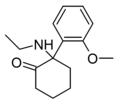 | 2-MeO-NEK [33] | o-Methoxyphenyl | Ethylamino | 2-Keto | |
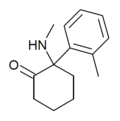 | oMDCK [34] | o-Tolyl | Methylamino | 2-Keto | 7063-37-8 |
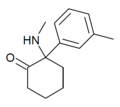 | mMDCK | m-Tolyl | Methylamino | 2-Keto | |
 | meta-Ketamine | m-Chlorophenyl | Methylamino | 2-Keto | 7063-53-8 |
 | iso-Ketamine | o-Chlorophenyl | Methylamino | 4-Keto | |
 | 2-Fluorodeschloroketamine | o-Fluorophenyl | Methylamino | 2-Keto | 111982-50-4 |
 | 3-Fluorodeschloroketamine | m-Fluorophenyl | Methylamino | 2-Keto | 2657761-23-2 |
 | Bromoketamine | o-Bromophenyl | Methylamino | 2-Keto | 120807-70-7 |
 | TFMDCK | o-Trifluoromethylphenyl | Methylamino | 2-Keto | 1782149-73-8 |
 | SN 35210 [35] | o-Chlorophenyl | Carbomethoxybutylamino | 2-Keto | 1450615-41-4 |
 | Methoxetamine | m-Methoxyphenyl | Ethylamino | 2-Keto | 1239943-76-0 |
 | Methoxmetamine | m-Methoxyphenyl | Methylamino | 2-Keto | 1781829-56-8 |
 | Methoxpropamine | m-Methoxyphenyl | n-Propylamino | 2-Keto | 2504100-71-2 |
 | MXiPr | m-Methoxyphenyl | i-Propylamino | 2-Keto | |
 | Ethoxetamine | m-Ethoxyphenyl | Ethylamino | 2-Keto | |
 | Deoxymethoxetamine (3-Me-2'-Oxo-PCE) | m-Tolyl | Ethylamino | 2-Keto | 2666932-45-0 |
 | Br-MXE | 2-bromo-5-methoxyphenyl | Ethylamino | 2-Keto | |
 | Hydroxetamine (HXE) | m-Hydroxyphenyl | Ethylamino | 2-Keto | 1620054-73-0 |
 | HXM | m-Hydroxyphenyl | Methylamino | 2-Keto | |
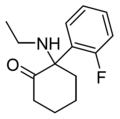 | 2F-NENDCK | o-Fluorophenyl | Ethylamino | 2-Keto | |
 | Fluorexetamine (FXE) | m-Fluorophenyl | Ethylamino | 2-Keto | |
 | Phencyclidine (PCP) | Phenyl | Piperidine | - | 77-10-1 |
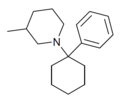 | PC3MP | Phenyl | 3-Methylpiperidine | - | 2201-41-4 |
 | PC4MP | Phenyl | 4-Methylpiperidine | - | 2201-42-5 |
 | Rolicyclidine (PCPy) | Phenyl | Pyrrolidine | - | 2201-39-0 |
 | PCDMPy | Phenyl | 3,3-Dimethylpyrrolidine | - | |
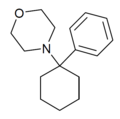 | PCMo | Phenyl | Morpholine | - | 2201-40-3 |
 | Methoxy-PCM [7] (2'-MeO-PCMo) | o-Methoxyphenyl | Morpholine | - | 1314323-88-0 |
 | 3'-MeO-PCMo | m-Methoxyphenyl | Morpholine | - | 138873-80-0 |
 | 4'-MeO-PCMo | p-Methoxyphenyl | Morpholine | - | |
 | Methyl-PCM [36] (4'-Me-PCMo) | p-Tolyl | Morpholine | - | 120803-52-3 |
 | Hydroxy-methyl-PCM | 2-Methyl-4-hydroxyphenyl | Morpholine | - | 1314323-89-1 |
 | PYCP [37] | 2-Pyridinyl | Piperidine | - | |
 | TCM | 2-Thienyl | Methylamino | - | 139401-07-3 |
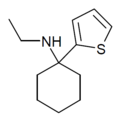 | TCE | 2-Thienyl | Ethylamino | - | 101589-62-2 |
 | TCPr [38] | 2-Thienyl | Propylamino | - | |
 | Tenocyclidine (TCP) | 2-Thienyl | Piperidine | - | 21500-98-1 |
 | T3CP | 3-Thienyl | Piperidine | - | 19420-50-9 |
 | TCPy | 2-Thienyl | Pyrrolidine | - | 22912-13-6 |
 | Tiletamine | 2-Thienyl | Ethylamino | 2-Keto | 14176-49-9 |
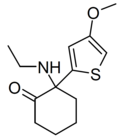 | MXTE | 4-Methoxy-2-thienyl | Ethylamino | 2-Keto | |
 | Gacyclidine | 2-Thienyl | Piperidine | 2-Methyl | 68134-81-6 |
 | BDPC | p-Bromophenyl | Dimethylamino | 4-Phenethyl-4-hydroxy | 77239-98-6 |
 | C-8813 | p-Bromophenyl | Dimethylamino | 4-(thiophen-2-yl)ethyl-4-hydroxy | 616898-54-5 |
 | Dimetamine [39] | p-Tolyl | Dimethylamino | 4-Keto | 65619-06-9 |
 | 3''-OH-2'-Me-PCP [40] | o-Tolyl | 3-Hydroxypiperidine | - | |
 | 4''-Ph-4''-OH-PCP [41] | Phenyl | 4-Phenyl-4-hydroxypiperidine | - | 77179-39-6 |
 | BTCP [42] | Benzothiophen-2-yl | Piperidine | - | 112726-66-6 |
 | BTCPy [10] | Benzothiophen-2-yl | Pyrrolidine | - | |
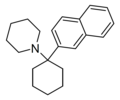 | GK-189 [43] | Naphthalen-2-yl | Piperidine | - | 81490-58-6 |
Other similar compounds exist where the base ring has been varied, or the amine chain replaced with other groups. [44] More cycloalkane ring sizes have been experimented with than just purely thinking in terms of the cyclohexylamine. The cyclopentyl homologue of PCP is active with around one-tenth the potency, [45] while the cycloheptyl and cyclooctyl derivatives are inactive, though some substituted arylcycloheptylamines retain activity. [46] The requisite cycloalkylketone is reacted with PhMgBr; 3° alcohol is then reacted with NaN3; azide then reduced with LAH. Then in the final step the piperidine ring is constructed with 1-5-dibromo-pentane. [47] Other compounds are known where the cyclohexyl base ring is replaced by rings such as norbornyl, adamantyl, [48] tetralin, oxane, thiane [49] or piperidine. [50] Conformationally constrained analogs have been prepared and researched by Morieti et al. [51]
| Structure | Compound | Aryl Substituent | N Group | Base ring | CAS number |
|---|---|---|---|---|---|
 | PCPEP | Phenyl | Piperidine | Cyclopentyl | 23036-19-3 |
 | 3F-PCHEPy | 3-Fluorophenyl | Pyrrolidine | Cycloheptyl | |
 | 3-MeO-PBCHP | 3-Methoxyphenyl | Piperidine | Bicyclo[2.2.1]heptane | |
 | PADP (P2AP) | Phenyl | Piperidine | Adamantyl | 72241-99-7 |
 | 3-MeO-PTP | 3-Methoxyphenyl | Piperidine | Tetralin | |
 | HHFA | Fused phenyl | Amino | Hexahydrofluorene | |
 | DHPQ | Phenyl | Decahydroquinoline | ||
 | POXP | Phenyl | Piperidine | Oxane | |
 | PTHP | Phenyl | Piperidine | Thiane | |
 | MPBPip | Phenyl | Piperidine | N-Methylpiperidine | 36882-04-9 |
 | BnCP | Benzyl | Piperidine | Cyclohexyl | 22912-07-8 |
 | YNCP | Ethynyl | Piperidine | Cyclohexyl | 51165-02-7 |
 | ALCP | Allyl | Piperidine | Cyclohexyl | 7418-80-6 |
 | Piritramide | Replaced by carboxamide | Piperidine | N-(3-cyano-3,3-diphenylpropyl)piperidine | 302-41-0 |
 | PRE-084 | Phenyl | Morpholinylethylcarboxylate | Cyclohexyl | 138847-85-5 |
 | Clofenciclan | p-Chlorophenyl | Diethylaminoethoxy | Cyclohexyl | 5632-52-0 |

Phencyclidine or phenylcyclohexyl piperidine (PCP), also known in its use as a street drug as angel dust among other names, is a dissociative anesthetic mainly used recreationally for its significant mind-altering effects. PCP may cause hallucinations, distorted perceptions of sounds, and violent behavior. As a recreational drug, it is typically smoked, but may be taken by mouth, snorted, or injected. It may also be mixed with cannabis or tobacco.

Eticyclidine is a dissociative anesthetic drug with hallucinogenic effects. It is similar in effects to phencyclidine but is slightly more potent. PCE was developed by Parke-Davis in the 1970s and evaluated for anesthetic potential under the code name CI-400, but research into PCE was not continued after the development of ketamine, a similar drug with more favourable properties. PCE is slightly more potent than PCP and has similar effects, but its unpleasant taste and tendency to cause nausea made it less accepted by users. Due to its similarity in effects to PCP, PCE was placed into the Schedule 1 list of illegal drugs in the 1970s, although it was only briefly abused in the 1970s and 1980s and is now little known.

Ohmefentanyl is an extremely potent opioid analgesic drug which selectively binds to the µ-opioid receptor.

(+)-CPCA is a stimulant drug similar in structure to pethidine and to RTI-31, but nocaine is lacking the two-carbon bridge of RTI-31's tropane skeleton. This compound was first developed as a substitute agent for cocaine.

Etoxadrol (CL-1848C) is a dissociative anaesthetic drug that has been found to be an NMDA antagonist and produce similar effects to PCP in animals. Etoxadrol, along with another related drug dexoxadrol, were developed as analgesics for use in humans, but development was discontinued in the late 1970s after patients reported side effects such as nightmares and hallucinations.

Propiram is a partial μ-opioid receptor agonist and weak μ antagonist analgesic from the ampromide family of drugs related to other drugs such as phenampromide and diampromide. It was invented in 1963 in the United Kingdom by Bayer but was not widely marketed, although it saw some limited clinical use, especially in dentistry. Propiram reached Phase III clinical trials in the United States and Canada.

Azaprocin is a drug which is an opioid analgesic with approximately ten times the potency of morphine, and a fast onset and short duration of action. It was discovered in 1963, but has never been marketed.

Benocyclidine, also known as benzo

3-Methoxyphencyclidine (3-MeO-PCP) is a dissociative hallucinogen of the arylcyclohexylamine class related to phencyclidine (PCP) which has been sold online as a designer drug. It acts mainly as an NMDA receptor antagonist, though it has also been found to interact with the sigma σ1 receptor and the serotonin transporter. The drug does not possess any opioid activity nor does it act as a dopamine reuptake inhibitor.

4-Methoxyphencyclidine is a dissociative anesthetic drug that has been sold online as a research chemical. The synthesis of 4-MeO-PCP was first reported in 1965 by the Parke-Davis medicinal chemist Victor Maddox. A 1999 review published by a chemist using the pseudonym John Q. Beagle suggested the potency of 4-MeO-PCP in man was reduced relative to PCP, two years later Beagle published a detailed description of the synthesis and qualitative effects of 4-MeO-PCP, which he said possessed 70% the potency of PCP. 4-MeO-PCP was the first arylcyclohexylamine research chemical to be sold online, it was introduced in late 2008 by a company trading under the name CBAY and was followed by several related compounds such as 3-MeO-PCP and methoxetamine. 4-MeO-PCP has lower affinity for the NMDA receptor than PCP, but higher affinity than ketamine, it is orally active in a dosage range similar to ketamine, with some users requiring doses in excess of 100 mg for desired effects. Users have reported substantial differences in active dose, these discrepancies can be partially explained by the presence of unreacted PCC and other impurities in samples sold on the grey market. 4-MeO-PCP has Ki values of 404 nM for the NMDA receptor, 713 nM for the norepinephrine transporter, 844 nM for the serotonin transporter, 296 nM for the σ1 receptor and 143 nM for the σ2 receptor.

PCPr is an arylcyclohexylamine dissociative anesthetic drug with hallucinogenic and stimulant effects. It is around the same potency as phencyclidine, although slightly less potent than the ethyl homologue eticyclidine, and has reportedly been sold as a designer drug in Germany and other European countries since the late 1990s.

G-130 is a drug with stimulant and anorectic effects, related to phenmetrazine.

MT-45 (IC-6) is an opioid analgesic drug invented in the 1970s by Dainippon Pharmaceutical Co. It is chemically a 1-substituted-4-(1,2-diphenylethyl) piperazine derivative, which is structurally unrelated to most other opioid drugs. Racemic MT-45 has around 80% the potency of morphine, with almost all opioid activity residing in the (S) enantiomer. It has been used as a lead compound from which a large family of potent opioid drugs have been developed, including full agonists, partial agonists, and antagonists at the three main opioid receptor subtypes. Fluorinated derivatives of MT-45 such as 2F-MT-45 are significantly more potent as μ-opioid receptor agonists, and one of its main metabolites 1,2-diphenylethylpiperazine also blocks NMDA receptors.

Ephenidine is a dissociative anesthetic that has been sold online as a designer drug. It is illegal in some countries as a structural isomer of the banned opioid drug lefetamine, but has been sold in countries where it is not yet banned.

3-MeO-PCMo is a dissociative anesthetic drug which is similar in structure to phencyclidine and been sold online as a designer drug. The inhibitory effect of 3-MeO-PCMo on the reduction in the density of the drebrin clusters by NMDAR stimulation with glutamic acid is lower than that of PCP or 3-MeO-PCP, with half maximal inhibitory concentration (IC50) values of 26.67 μM (3-MeO-PCMo), 2.02 μM (PCP) and 1.51 μM (3-MeO-PCP).

3-Hydroxyphencyclidine (3-HO-PCP) is a dissociative of the arylcyclohexylamine class related to phencyclidine (PCP) that has been sold online as a designer drug.

3-Methyl-PCPy (3-Me-PCPy) is an arylcyclohexylamine derivative with an unusual spectrum of pharmacological effects, acting as both a potent NMDA antagonist and also a triple reuptake inhibitor which inhibits reuptake of all three monoamine neurotransmitters serotonin, dopamine and noradrenaline. It also acts as a high affinity sigma receptor ligand, selective for the σ2 subtype. It produces both stimulant and dissociative effects in animal behavioural studies.

3-Methyl-PCP is a recreational designer drug with dissociative effects. It is an arylcyclohexylamine derivative, related to drugs such as 3'-MeO-PCP and 3'-Me-PCPy. It was first synthesised in the 1960s, but was only identified on the illicit market in Hungary in September 2020, and was made illegal in Hungary in April 2021.

3-Fluoro-PCP is a recreational designer drug from the arylcyclohexylamine family, with dissociative effects. It was first identified in Slovenia in October 2020, and was made illegal in Hungary in April 2021.